Kaiteriteri to Pohara
It was time to leave the golden sands of Kaiteriteri (see the previous blog), and carry on with our journey around the top section of the South Island – heading to Pohara.
Why We Chose Pohara
It wasn’t a long drive from Kaiteriteri to Pohara, only approximately 60km. Between us and them was the notorious Takaka Hill.
We wanted to set up a base so that we could explore the area without having the caravan hitched on the back.
One of the other choices we considered was Totaranui (this is covered off later in the blog). We had visited Totaranui years ago during our tour coach driving days. It is a magical spot but the weather forecast wasn’t very favourable which meant a mark against it when it came to decision making.
The other thing against Totaranui is that there is only a DOC camp to stay at. Not that this is an issue, but the new DOC passes weren’t available to purchase yet so it was going to cost us $15 each per night.
Port Tarakohe, Pohara
So Pohara it was. If you are a member of the NZMCA, there is a park available – Port Tarakohe (#6021), right on the water beside the Boat Club. It is only $3 each per night so was much kinder on the pocket.
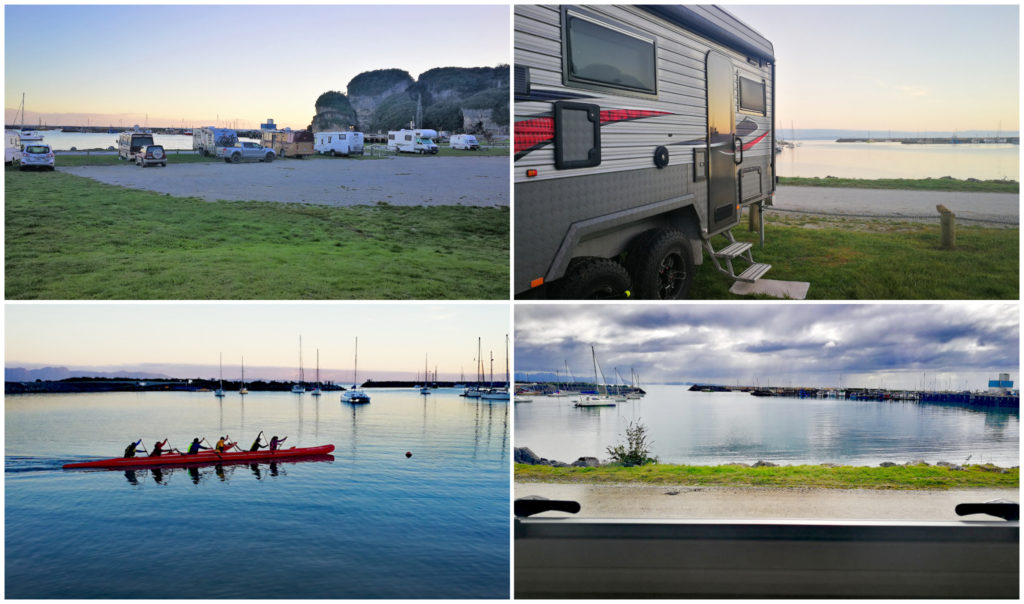
Port Tarakohe, Pohara, always something to see right outside the back window
The park is a spacious, gated area which overlooks the comings and goings of the small harbour and wharf, which is sheltered from the swells by a breakwater.
There are facilities at the Boat Club that members can use with a combination lock for access. Toilets, showers, a washing machine and dryer are available.
Pets are welcome providing they are kept on a leash due to nearby nesting penguins.
If you are lucky enough to be there on a Sunday evening, you can pop over to the club for a roast dinner.
If you are not an NZMCA member, your other option is the Pohara Beach Top 10 Holiday Park just 2km away.
I understand that the Port Tarakohe park may be on borrowed time as the land has been earmarked for future development. It may pay you to make the most of it while you can.
Te Waikoropupu (Pupu) Springs
Just 15km from Pohara you will find the Te Waikoropupu Springs (Pupu Springs).
It has been nearly 20 years since we last visited these springs and it has certainly undergone a transformation. Thankfully, the springs are still just as pristine and clear as I remember them, but the access and viewing platforms have been improved.
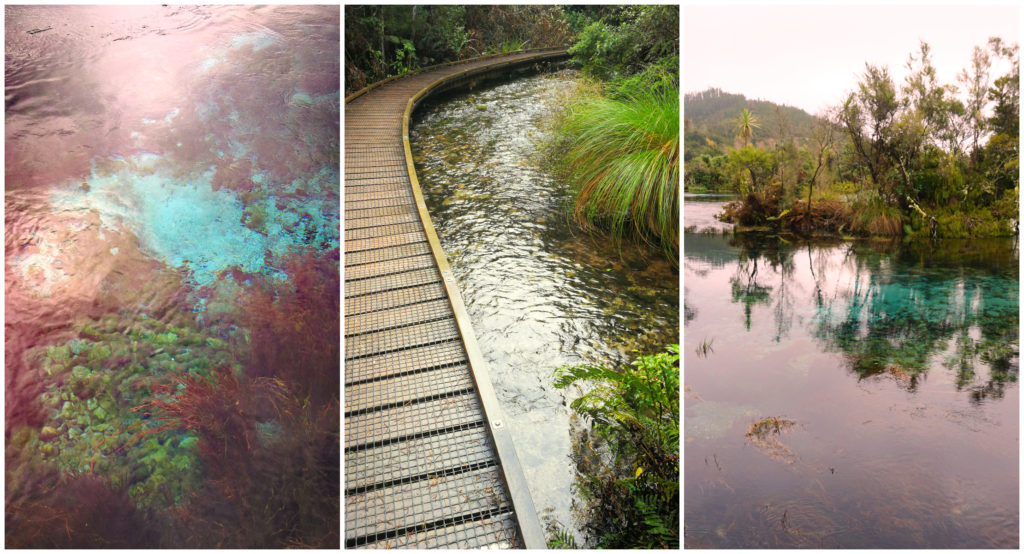
Photos just don’t do it justice, such clarity down to the depths of the springs
There is a 30-minute loop track which allows great viewing to the bottom of some of the springs – some 63 metres down. There are only a couple of other places which boast water with more purity. That is under the Ross ice shelf in Antarctica and the Blue Lake in the Tasman area.
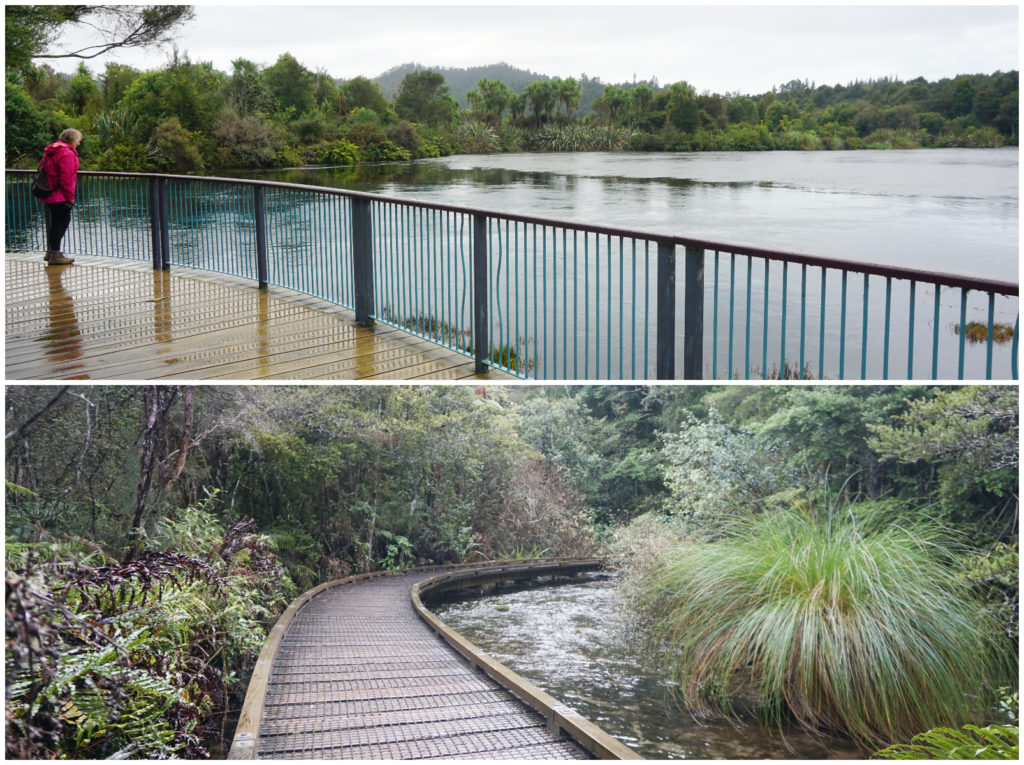
The viewing platforms and pathway have undergone a makeover
The springs discharge a whopping 14,000 litres of water a second which comes from 8 water vents. What I thought was quite interesting is that the water is at a constant 11.7 degrees.
As I mentioned earlier, the water and surroundings are remarkably pristine. Considering this area has a high concentration of foot traffic, it’s encouraging to see that it treated with respect by all who visit. The springs are spiritually significant to the Maori people. They no longer allow diving, swimming and all bodily contact, including filling of water bottles. These activities have been banned since 2006. Dogs are also banned from entering the area.
Totaranui
Our History with Totaranui
As mentioned earlier, we were keen to retrace our footsteps of over 20 years ago, and drive into Totaranui. Back in the days of our tour driving careers, Scotty had the challenge of driving a 48 seater tour coach into Totaranui to pick up me (tour guide) and our 45 senior citizen passengers from our Kaiteriteri to Totaranui boat trip.
This was undertaken after reassurance from a local tour company that the roads were tour coach friendly. What they didn’t explain was that they were referring to a 20 seater coach. There is a significant difference between the two when you are talking about wheelbase, turning circles and traction.
I can honestly say that I’m still mentally scarred from that trip back out of Totaranui in that coach. The road today is nothing like it was back then and we were still able to identify the most terrifying corners Scotty had to navigate around. There was more than one occasion where he took 3 or 4 attempts to maneuver the coach around some of those bends with the dual wheels skidding and sliding on the clay base.
I was a couple of whiter shades of pale by the time we came out the other end. All the while trying to act calm in front of 45 passengers, reassuring them that all was under control.
A Walk in the Park
The road has been improved since our traumatic experience and there would be no problems today in navigating those horrendous corners and hills.
The Totaranui DOC camp is a huge area of land that encompasses the northern end of the Abel Tasman National Park. There are in fact a total of 269 non-powered sites.
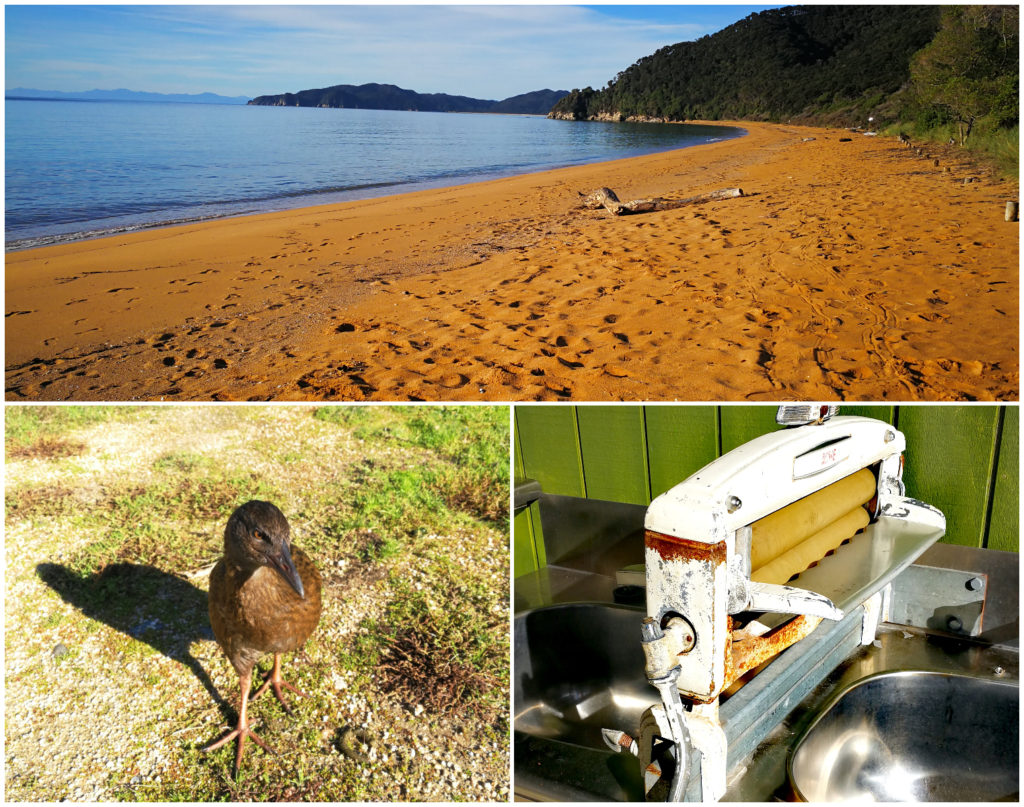
The DOC camp hugs this pristine sweeping beach at Totaranui, Wally the Weka comes to say hello and the wringer for the handwashing
It is a very popular spot for holidaymakers and those who are walking the Abel Tasman Coastal track.
The Coastal track in its entirety will take you anywhere between 3-5 days. If you want to see one of the best beaches in the Abel Tasman National Park but can’t be bothered with days of hiking or you lack the time (and fitness) then the track from Totaranui to Goat Bay is the place for you.
We parked up at the camp and set off to hike this section of the Great Walk. We headed towards Goat Bay which is about a 2-hour return hike.
Skinner Point Lookout
Climbing the first peak to get to Goat Bay, you arrive at Skinner Point. You will certainly want to take this short detour. This lookout boasts views across both Totaranui Beach and Goat Bay. This is the type of view everyone looks for when hiking in the Abel Tasman National Park. It is truly an incredible vista as you can see further towards the southern end of the national park’s coastline. I believe that it is one of the best viewpoints on the Abel Tasman Coastal Track.
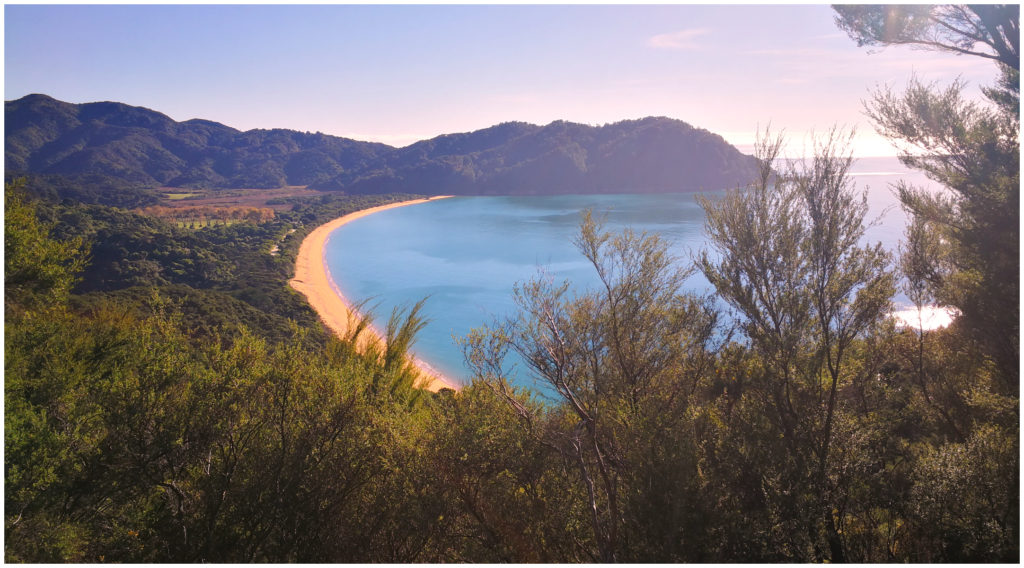
The view back down towards Totaranui from Skinner Point lookout
Goat Bay
The track continues (all downhill thank goodness!) down to Goat Bay. Emerging from the depths of native bush to find a deserted, stunning white sand beach is one of the highlights of any of sections of the Abel Tasman National Park hikes.
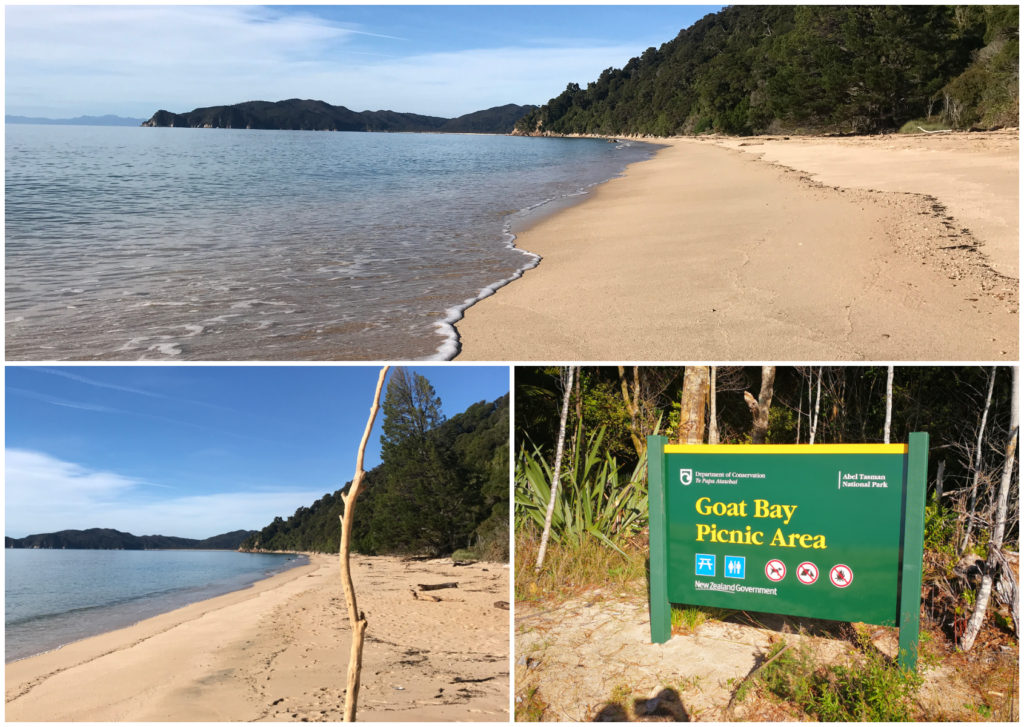
Not another sole as we wandered down Goat Bay
We wandered along the pristine sand, with our footprints being the only evidence of humans, well for that day anyway. This is one of the joys of travelling in winter in New Zealand, especially mid-week.
We walked along almost the full length of the beach and then headed back to Totaranui.
Awaroa Inlet
Leaving Totaranui, we wanted to make the most of not having the caravan in tow so we took the turnoff to Awaroa Inlet.
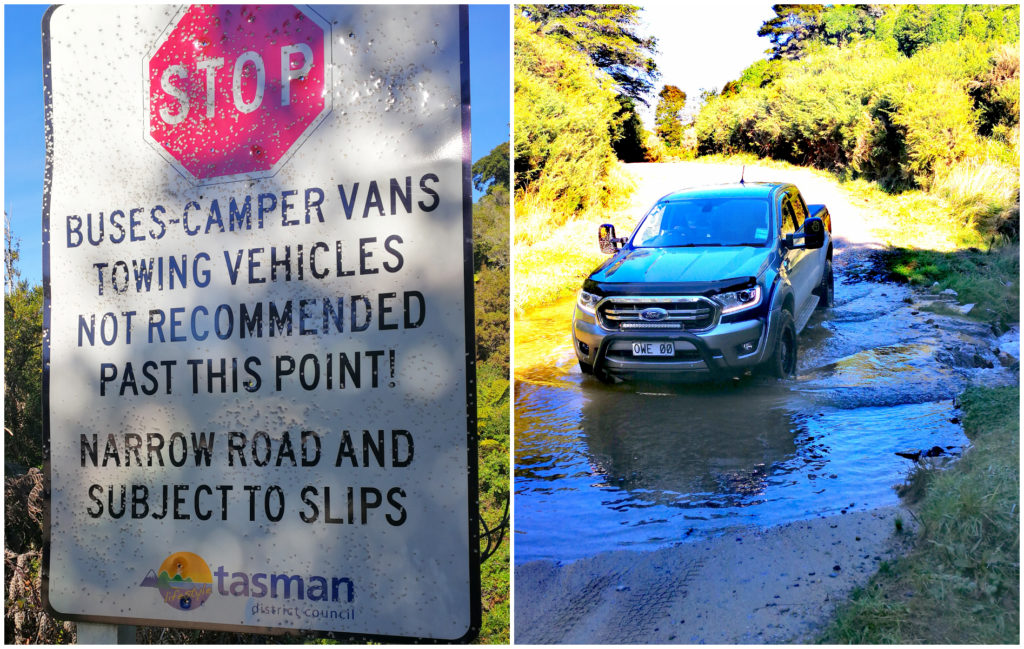
It’s a good idea to heed the warning signs
It would probably be a good idea to heed the warning sign ‘not recommended for campers or caravans’. The road condition reminded us of how the Totaranui road used to be. It is metal and has clay patches in places, narrow, steep and with some tight corners. Apart from all of those hazards, it’s an amazing road to explore and we soon arrived at the parking area for the Awaroa Inlet.
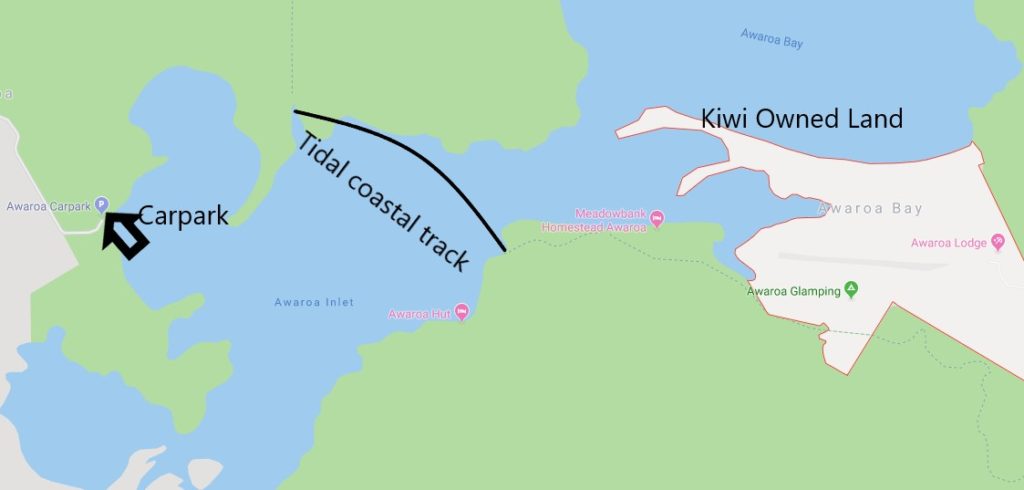
The road takes you to carpark marked, the estuary crossing on low tide and the Kiwi-owned land
The inlet is part of the Abel Tasman Coastal Walkway and has a low-tide estuary crossing to the other side. You can then continue on your way along the track.
Awaroa Bay – Kiwi Owned
Many may know the name Awaroa Bay when the quest to buy ‘The NZ Beach’ at Awaroa gripped the country in 2016. The nation rallied to raise the money through a Crowd Funding website. The pledge closed on 15 February 2016 and saw over 39,000 Kiwis raise $2.3 million in just 3 weeks. There was a helping hand from the NZ Government and the Joyce Fisher Charitable Trust to bring it up to an acceptable purchase price. The country then handed it back. A gift from NZ’ers to NZ. The area is now managed by DOC.
A big part of its appeal is its remoteness. You can walk there from the carpark at Awaroa Inlet (on low tide), a detour from the Abel Tasman Coastal Track (also on low tide), or a boat trip from either Kaiteriteri or Marahau.
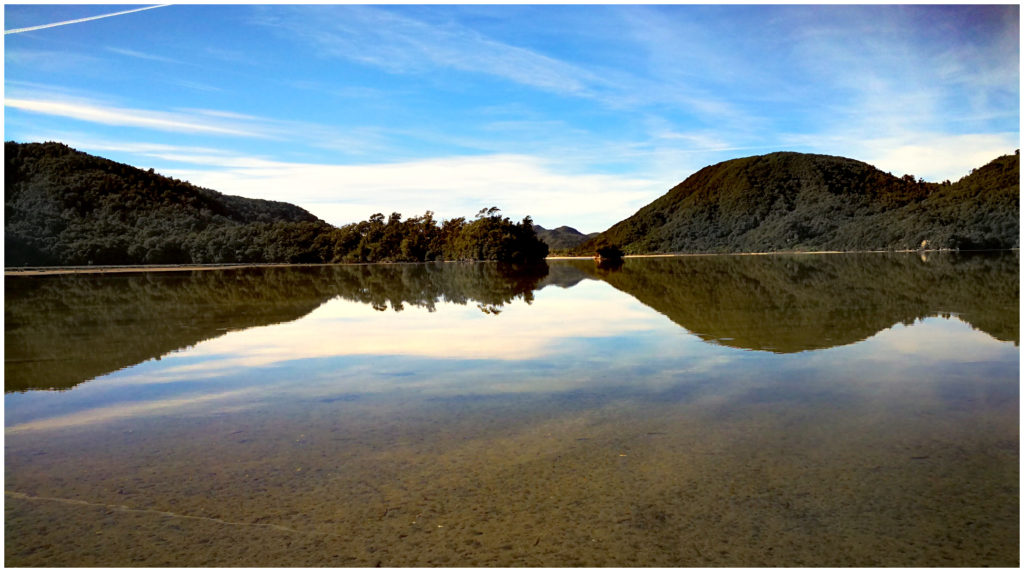
the reflections were mesmerising
The tide was not in our favour as it was well and truly in. We didn’t fancy having to walk the long way around the estuary so we sat and marvelled the view from the foreshore of the nearby carpark while we ate a late lunch. The reflections on the still inlet water were mesmerising which made up for it being high tide.
Wainui Falls
Our next stop on the way back to base camp at Pohara was Wainui Falls. You can easily see the turnoff on the main road back from Totaranui (approx 11km from Pohara).
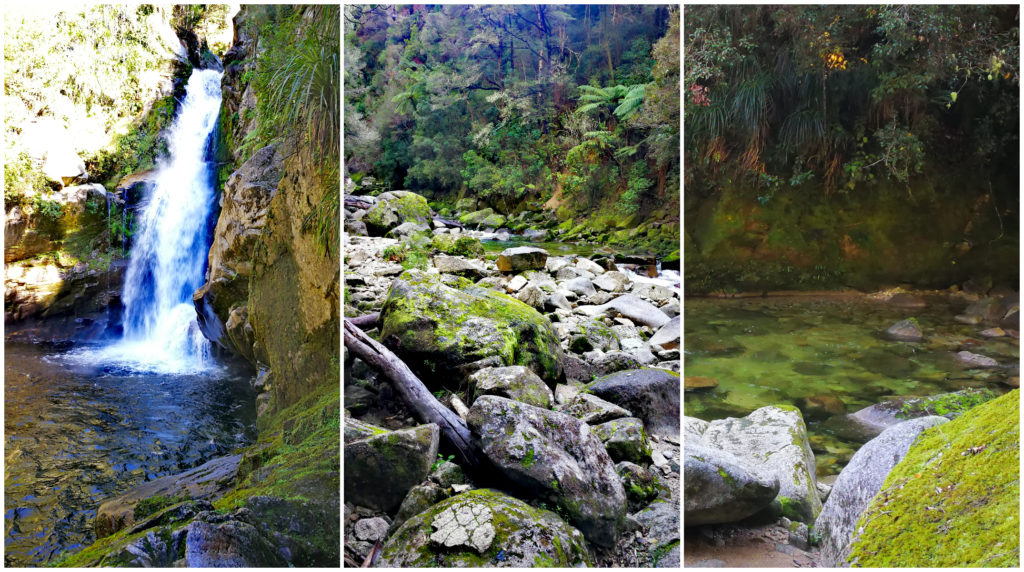
The track wanders between boulders, follows the river and ends up at the 7m falls
It takes around 30 minutes to get to the falls. You firstly cross farmland for a short distance before entering forests of nikau palms, rata trees and native ferns. The track rapidly climbs and weaves its way around boulders, following the crystal clear pristine green water of the Wainui River.
There is a very picturesque suspension bridge on the way. Below you can see old logs piled up after what must have been massive floods.
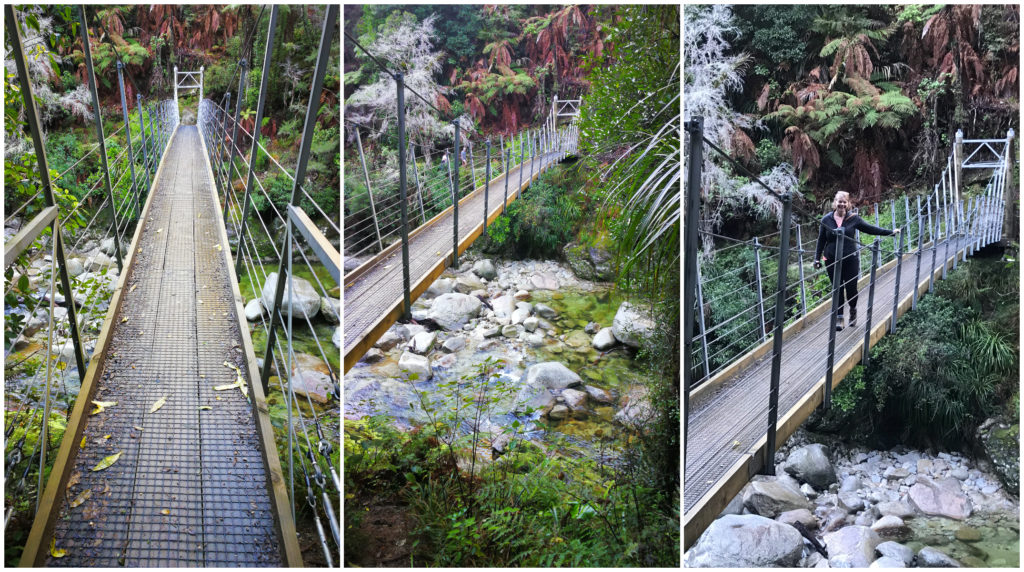
not the scariest suspension bridge I’ve been on but certainly has a good swing to it
You know you are starting to get close to the falls when you can hear the sound of rushing water. The 7 metre high falls is said to be the most impressive in all of the Abel Tasman National Park.
I can understand why the deep pools at the base of the falls and dotted along the river are so popular in the heat of summer. Today, not so inviting as the water looked as cold as it probably felt!
We returned to the Wainui Falls car park on the same track.
Summary
If you are members of the NZMCA then I would recommend you make the most of the Port Tarakohe, Pohara park while you still can. It made an excellent base for our exploration of this section of the Abel Tasman.
Click on the link below for a video of our highlights staying at Pohara, featuring Pupu Springs, Totaranui, Abel Tasman Walkway, Awaroa Inlet and Wainui Falls.
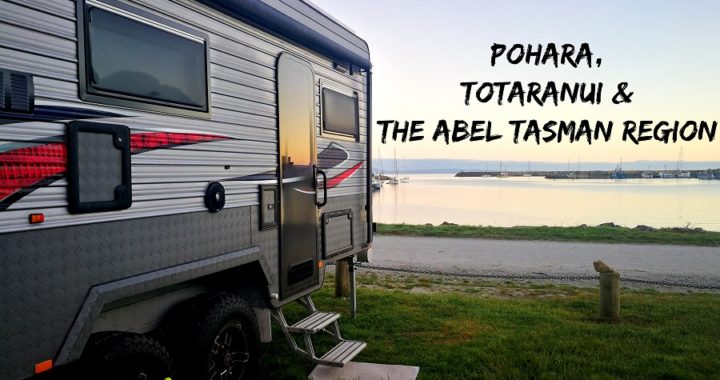
Great Blog!!! 😀 We just loved our time in that area and like us you have visited outside peak holiday times so although the waters probably to cold for a swim at Totaranui you can still enjoy all the rest the place has to offer.
Thanks guys, we are all so lucky to live the lifestyle we do.
What a fantastic read! We love NZ and have been a few times now – our favourite trip was driving around the South Island for three weeks in a hired motorhome. If I didn’t see lambs or snow capped mountains every day I had withdrawal symptoms! (We were there in September).
Have definitely made note of the Pohara Holiday Park in case we are ever in the vicinity.
Wonderful photos!
Thanks Joycee. September is certainly the month to see lottsa lambs for sure! L